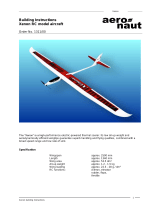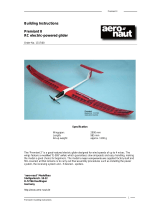
22
and you will need a lot of skill to make use of them. With a
little practice you will be able to recognise likely trigger points
for thermals in the local landscape. The ground warms up
in the sun’s heat, but heat absorption varies according to
the type of terrain and the angle of the sun’s rays. The air
over the warmer ground becomes warmer in turn, and the
mass of warm air ows along close to the ground, driven
by the breeze. Strong winds usually prevent thermal build-
up. Any obstruction - a shrub or tree, a fence, the edge of
a wood, a hill, a passing car, even your own model on the
landing ap-proach - may cause this warm air to leave the
ground and rise. Imagine a drop of water on the ceiling,
wandering around aimlessly, and initially staying stuck to
the ceiling. If it strikes an obstruction it will fall on your head.
A triggered thermal can be thought of as the opposite of
the drop of water.
The most obvious thermal triggers include sharply dened
snow elds on mountain slopes. The air above the snow
eld is cooled, and ows downhill; at the edge of the snow
eld, part-way down the valley, the cool air meets warm air
owing gently uphill, and pushes it up and away as if cut off
by a knife. The result is an extremely powerful but bumpy
thermal bubble. Your task is to locate the rising warm air and
centre your model in it. You will need to control the glider
constantly to keep it centred, as you can expect the most
rapid climb rate in the core of the thermal. Once again, this
technique does demand some skill.
To avoid losing sight of the machine be sure to leave the
thermal in good time. Remember that a glider is always
easier to see under a cloud than against a clear blue sky.
If you have to lose height in a hurry, do bear the following
in mind:
The structural strength of the Heron is very great for this
class of model, but it is not innite. If you attempt to destroy
the model forcibly, please don’t expect any sympathy or
compensation from us (alas, we speak from experience).
43. Flying at the slope
Ridge soaring is an extremely attractive form of model ying.
Soaring for hours on end in slope lift, without needing any
outside aid for launching, must be one of the nest of mo-
delling experiences. But to “milk” a thermal to the limits of
vision, bring it down again in a continuous series of aerobatic
manoeuvres, and then repeat the whole show - that must
surely be the last word in model ying.
But take care - there are dangers for your model lurking
at the slope. Firstly, in most cases landing is much more
difcult than at a at eld site. It is usually necessary to land
in the lee of the hill where the air is turbulent; this calls for
concentration and a high-speed approach with last-minute
airbrake extension. A landing on the slope face, i.e. right
in the slope lift, is even more difcult. Here the trick is to
approach slightly downwind, up the slope, and are at ex-
actly the right moment, just before touch-down.
44. Aero-towing
An ideal combination for learning to aero-tow, and for actual
aero-towing, is a FunCub and a Heron.
For the tow you require a 20 m length of braided cable of
1 to 1.5 mm Ø. Tie a loop of nylon line (0.5 mm Ø) to the
glider end of the cable; this acts as a “weak link”, in case
the tow should go badly wrong.
A loop in the other end of the towline should be connected to
the aero-tow coupling of the FunCub. Assemble the models,
connect them as described, and set them up directly into
wind, the glider behind the tug. Check that the towline is
resting on top of the FunCub’s tailplane. The tug now rolls
forward until the towline is taut, and only then should the
tug’s pilot apply full-throttle. Both aeroplanes accelerate:
the tug stays on the ground initially, while the glider lifts
off, but the glider pilot keeps his model ying low above the
ground, directly in the wake of the tug; the tug can now lift
off safely. The two models should be kept climbing steadily,
even through turns. Avoid ying directly over your heads
during the rst few attempts at aero-towing, as it is difcult
to detect the models’ attitudes from this angle. To drop the
tow, operate the transmitter control which opens the tow
release mechanism.
45. Electric ying
With the electric version you have the optimum level of
autonomy and independence. You can y from a at eld
and carry out about seven climbs to a sensible gliding height
(around 150 m) from a single battery charge. At the slope
you can also keep the electric power system as a “lifebelt”,
i.e. you only use the motor to “keep aoat”, and avoid landing
out, i.e. landing at the bottom of the slope when the lift fails.
46. Flight performance
What is meant by a glider’s performance?
The two most important parameters are sinking speed and
glide angle. Sinking speed is a measure of the vertical
height lost per second relative to the surrounding air. The
sinking speed is primarily determined by the wing loading
(weight relative to wing area). Here the Heron offers a re-
ally excellent performance - much better than conventional
models - as its wing loading is so low. This means that only
slight thermal assistance is necessary (warm air rising) to
cause the model to gain height. Wing loading is also the
main factor in determining the model’s airspeed - the lower
the loading, the slower the model. Low airspeed means
that the model can be turned extremely tightly, and this is
also advantageous when thermal ying, as areas of lift are
usually very small when close to the ground.
The other important parameter in glider performance is the
glide angle. This is stated as a ratio, i.e. from a particular
altitude the model ies such and such a distance. The glide
angle increases as wing loading rises, and at the same time
- of course - the model’s airspeed increases. This becomes
necessary if you wish to y in relatively strong winds, and
when you need “energy retention” for ying aerobatics.
For thermal ying you need a good glide angle too, as this
is the key to ying across areas of “sink” (the opposite of a
thermal) quickly, so that you can seek out another thermal.
47. Safety
Safety is the First Commandment when ying any model
aircraft. Third party insurance is mandatory. If you join a
model club, suitable cover will usually be available through
the organisation. It is your personal responsibility to ensure
that your insurance is adequate (i.e. that its cover includes
powered model aircraft). Make it your job to keep your















